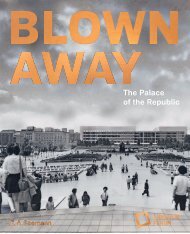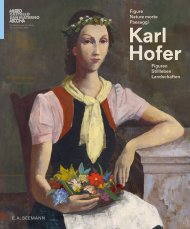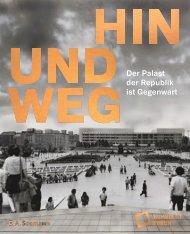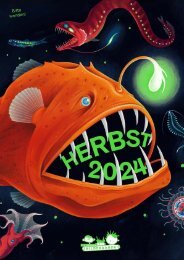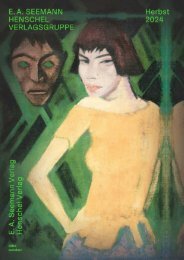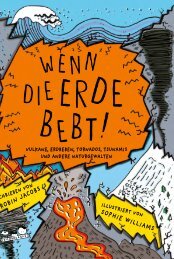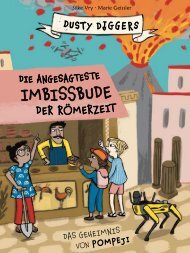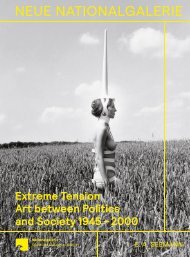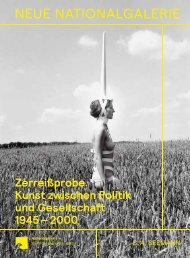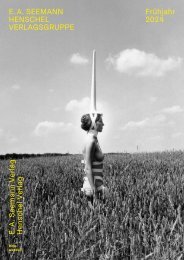Create successful ePaper yourself
Turn your PDF publications into a flip-book with our unique Google optimized e-Paper software.
we burn as much oil, natural gas and coal worldwide in<br />
a single day as was created over the course of 500,000<br />
years. 4 These fossil fuels are the drivers of economic<br />
growth and prosperity – a finite resource, the product<br />
of plants and animals that died millions of years ago.<br />
Humans are moving both <strong>with</strong>in and beyond their natural<br />
limits. They use three-quarters of the Earth’s surface<br />
and two-thirds of its oceans and have thus become a<br />
planetary force that is upsetting the balance of natural<br />
processes that are billions of years old. An estimated<br />
one million species are threatened <strong>with</strong> extinction. The<br />
decline of biodiversity also threatens the very basis of<br />
human life (Matthias Glaubrecht, p. 162). We have become<br />
our own gravediggers.<br />
Are we thus at the beginning of the end of human<br />
history? The Indian historian Dipesh Chakrabarty is “not<br />
optimistic, but hopeful” – because human beings are<br />
capable of learning. He suggests broadening the global<br />
perspective on the world to include a planetary view that<br />
decentres humanity and understands its history as part<br />
of natural history (Dipesh Chakrabarty, p. 184).<br />
The stories we tell about ourselves and our relationship<br />
to the world are among the most powerful tools we<br />
have as humans. Robin Wall Kimmerer, a plant ecologist<br />
and member of the Potawatomi people, calls for combining<br />
Indigenous wisdom <strong>with</strong> science to reform our<br />
relationship <strong>with</strong> nature. She wants to bring ancient stories<br />
to life, stories in which humans do not stand at the<br />
top of a hierarchy as the purported crown of creation,<br />
but rather exist in a symbiotic interdependence <strong>with</strong> all<br />
living things; as part of the biosphere, dependent also on<br />
the flourishing of the non-human living world (Robin Wall<br />
Kimmerer, p. 180).<br />
How can we live <strong>with</strong> the awareness of our natural<br />
transience and the vulnerability of all living things? How<br />
can we live better <strong>with</strong> the responsibility that comes<br />
<strong>with</strong> this knowledge? What cultural narrative helps us to<br />
channel our fear of death in constructive ways? Or, in the<br />
words of Ernest Becker: “What is life-enhancing illusion?”<br />
5 – for us personally, as a community, as a society,<br />
as a species, and for the planet?<br />
This book, like the exhibition, is rich in experiential<br />
knowledge. Many thanks are due to the people from<br />
Berlin’s urban society who shared their ideas about death<br />
and a piece of their lives <strong>with</strong> us, as well as to the palliative<br />
care providers from around the world for sharing<br />
their touching and enriching encounters, for giving us<br />
insight into their experiences of caring for the dying<br />
and thus a “glimpse of human nature” (Noreen Chan,<br />
p. 78). These conversations and encounters would not<br />
have been possible <strong>with</strong>out the support of numerous<br />
medi ators, translators and interviewers from around the<br />
world. My express thanks go to all the authors for their<br />
contributions and expertise.<br />
My special thanks go to the curatorial team, my “Circle of<br />
Trust”, Gesine Last and Jan Zappe, as versatile contributors<br />
and active thinkers for their invaluable support on<br />
various levels, Kathrin Haase for her support in researching<br />
the protagonists for the World <strong>Death</strong> Conference, and<br />
Yvonne Zindel for researching the diverse protagonists<br />
from Berlin’s urban society <strong>with</strong> their different conceptions<br />
of the hereafter.<br />
Last but not least, my thanks are due to the Humboldt<br />
Forum Foundation: General Director Hartmut Dorgerloh for<br />
his great trust, the exhibition team led by Anke Daemgen,<br />
David Blankenstein and Frank Meißner, as well as Sibylle<br />
Kussmaul and Marc Wrasse from the Education and<br />
Outreach Department for their support, Susanne Müller-<br />
Wolff as the person responsible for the publication for<br />
her careful planning, and Barbara Martinkat for her stylish<br />
image editing.<br />
Thanks also go to Sahar Aharoni, whose skilful design<br />
has made this book look so inviting, to Barbara Delius for<br />
decisively enhancing the publication <strong>with</strong> her critical and<br />
constructive view of the big picture and her unerring eye<br />
for detail, and to Danko Szabó for his copy editing.<br />
1 Ernest Becker, The Denial of <strong>Death</strong>, London 1973, p. 26.<br />
2 Philippe Ariès, Philippe Ariès, The Hour of Our <strong>Death</strong> [1977], trans. Helen<br />
Weaver, New York 1981, p. 95.<br />
3 Ibid., p. 610.<br />
4 Jürgen Renn, “Das Anthropozän und die Geschichte des Wissens”, 28 February<br />
2022; ww.br.de/mediathek/video/prof-dr-juergen-renn-das-anthropozaen-und-die-geschichte-des-wissens-av:5dce82a1ebea9c001ad6f8bd<br />
[accessed on 30 January 2023].<br />
5 Becker 1973 (see note 1) p. 158 [emphasis in the original].<br />
18 <strong>IN</strong>TRODUCTION DETLEF VÖGELI 19






